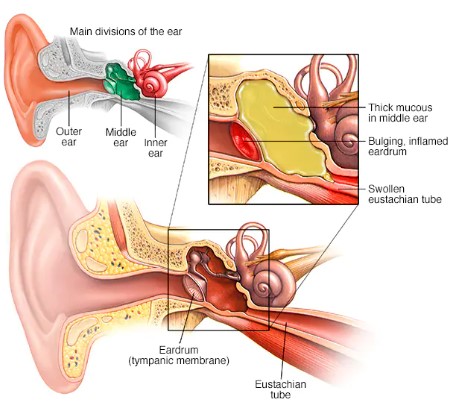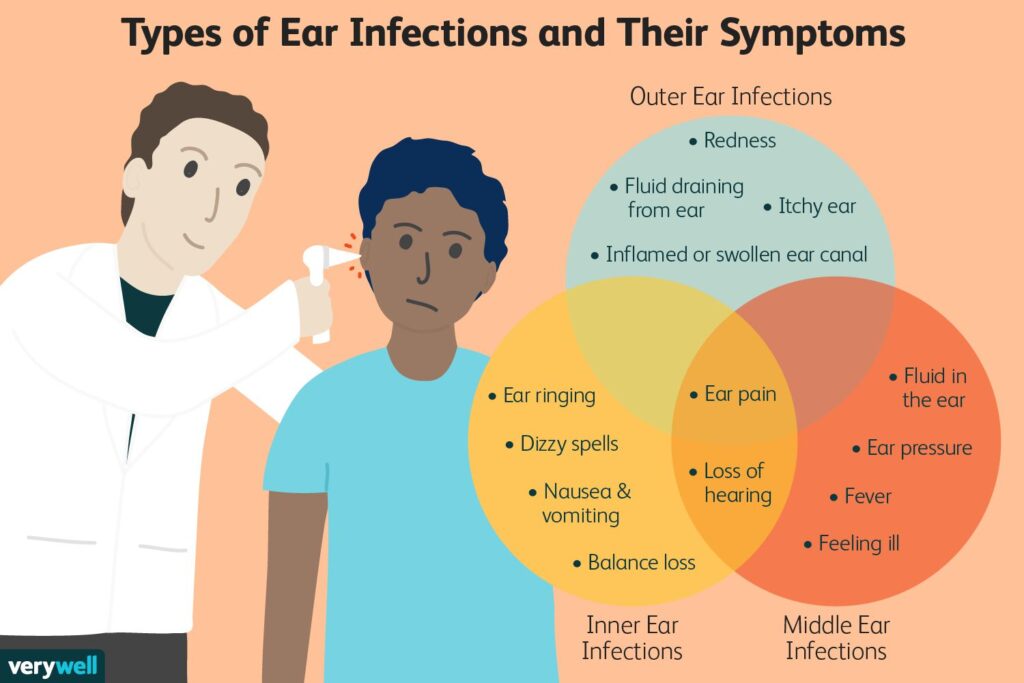
Although more common among children, ear infections in adults can be more serious and more likely to require medical treatment. Viruses, fungi, and bacteria can cause ear infections in adults. Some adults with chronic conditions may be more likely to develop them.
Experts estimate that 80–90% of children develop a middle ear infection before they start school. However, ear infections in adults are also not uncommon. A 2021 study finds that middle ear infections in adults occur at a rate of about 5.3 per 1,000 adults annually. Researchers also estimate that about 10% of people will experience outer ear infections in their lifetimes. What are the symptoms of an ear infection?
Ear infections generally fall into three categories, depending on which part of the ear they affect: inner, middle, and outer.

Inner ear
The inner ear includes the cochlea, which sends information about sound to your brain. It also includes the semicircular canals, which help your body determine its position. Labyrinthitis and vestibular neuritis are two adult inner ear infections that are usually viral.
Middle ear
The middle ear area includes the eardrum and the space behind it where three bones help conduct sound waves to the cochlea. People with middle ear infections often have an upper respiratory virus that causes part of their ear to become blocked. This blockage then traps fluid behind the eardrum.
Outer ear
The outer ear includes the ear canal and the auricle, the external part many people think of as the ear. Outer ear infections affect adults more often than children and can be very painful without treatment.
What are the causes of ear infections?
Viruses, bacteria, and fungi can all cause ear infections in adults. However, different parts of the ear become infected for different reasons.
While viruses commonly cause inner ear infections, doctors often do not know the cause when diagnosing the condition. Therefore, they may recommend resting and staying hydrated instead of prescribing antibiotics.
The virus that causes chickenpox and shingles can cause labyrinthitis when it reactivates. A middle ear infection can also spread to the inner ear.
Middle ear infections commonly develop due to an upper respiratory virus, influenza, or cold. These viral infections can clog up the eustachian tube, which runs from the ear to the throat. This clog keeps fluid in the ear from draining and can result in a secondary bacterial infection.

The bacteria Pseudomonas aeruginosa and Staphylococcus aureus are responsible for most outer ear infections. These bacteria can enter the ear canal from several sources:
earbuds
cotton swabs
hearing aids
eczema
sweat
warm weather conditions
Inner ear infection symptoms can include:
vertigo or dizziness
difficulty balancing
nausea and vomiting
hearing loss
tinnitus, or ringing in the ears
Middle ear infection symptoms can include:
ear pain
fluid draining from the ear
fever
muffled hearing or hearing loss
the sensation of fullness in the ear
Outer ear infection symptoms can include:
pain when pressing or pulling on the ear
itchiness
swelling
the sensation of fullness in the ear
mild fever
drainage

How do doctors diagnose ear infections?
To diagnose an ear infection, your doctor will ask about your symptoms and medical history. They will feel your lymph nodes and look in your ears with an otoscope, a lighted device with a magnifying lens. They may also check to see if your eardrum moves, which helps them determine if it is healthy.
Depending on the type of ear infection and severity of symptoms, your doctor also might conduct a hearing or imaging test. These additional tests can help them rule out other conditions.

How are ear infections treated?
Treating viral inner ear infections typically involves getting adequate rest, staying hydrated, and taking over-the-counter (OTC) pain medications. In some cases, steroids and vestibular system suppressants may be necessary. If a bacterial infection is a cause, doctors may prescribe antibiotic ear drops or oral antibiotics.
For a bacterial middle ear infection, doctors may prescribe oral or topical antibiotics. Some people experience chronic middle ear infections or fluid remaining in their ear after taking antibiotics. To treat this, a doctor may perform a minor procedure to place tubes in the affected eardrum to allow the fluid to escape. This procedure can also help prevent middle ear infections and make them easier to treat with antibiotic ear drops.
You can often manage outer ear infections with antibiotic ear drops and pain relievers. Your doctor may also need to clean the ear canal to allow topical treatments to work. Treatment with an oral pain reliever like acetaminophen (Tylenol) or ibuprofen (Motrin) usually helps alleviate fever and pain within a few hours. Many doctors will actually recommend alternating between Tylenol and Motrin for the best effect.
Antibiotics
If the infection is bacterial (rather than viral) you may receive a prescription for an oral or topical antibiotic. Here are some of the antibiotics doctors prescribe to treat an ear infection:
Amoxil (amoxicillin)
Augmentin (amoxicillin/potassium clavulanate)
Cortisporin (neomycin/polymxcin b/hydrocortisone) solution or suspension
Cortisporin TC (colistin/neomycin/thonzonium/hydrocortisone) suspension
Ciprodex (ciprofloxacin/dexamethasone) suspension
Cipro HC (ciprofloxacin/hydrocortisone) suspension
Ciloxan (ciprofloxacin) solution
Ocuflox (ofloxacin) solution
Floxin (ofloxacin) solution
Acetasol HC (hydrocortisone/acetic acid) solution

Your doctor will assess the type of bacteria likely causing your ear infection to determine which antibiotic to give you. Most people begin feeling relief within 24 hours of starting a course of antibiotics, and symptoms should improve significantly within 48-72 hours.
What’s the difference between antibiotic solutions and suspensions?
Solutions are liquids where the active ingredients are dissolved. Suspensions are liquids in which the particles are suspended, or scattered throughout the liquid, and not quite dissolved. Some medications are stable as a suspension but not as a solution.
The main difference between the two is how irritating they might be. Antibiotic solutions are generally more irritating than suspensions because solutions have a more acidic pH of 3-4, whereas suspensions have a less acidic pH of 5. (The pH scale ranges from 0-14 where 0 is the most acidic or irritating, 7 is neutral neither acidic or basic, and 14 is the most basic or least irritating.)
Solutions may also contain alcohol to help kill bacteria, but the alcohol can be extremely irritating when these solutions are applied.
FAQs
Can Covid start with ear pain?
Is an ear infection a symptom of COVID-19? Ear infections and COVID-19 share a few common symptoms, most notably fever and headache. Ear infections are not a commonly reported symptom of COVID-19.
When should I go to the doctor for an ear infection?
You should contact your doctor immediately if: The symptoms do not improve within 3 days. Body temperature rises above 100.4 degrees as an accompanying fever could indicate a more serious infection. Ear infections are being experienced regularly, as they can eventually lead to hearing loss.
What are the risk factors for ear infections?
People who are more likely to develop ear infections may have chronic conditions, such as:
weakened immune system
HIV
diabetes
allergies or eczema
conditions that require long-term antibiotic use
recurrent ear infections
cleft palate
exposure to secondhand smoke
What are some potential complications of ear infections?
Ear infections can spread to other parts of the ear, head, or neck without effective treatment. Ear infections can also cause:
mastoiditis, or an infection of the bone just behind the ear
permanent hearing loss
persistent balance issues
long-term vertigo
brain abscess
Can ear infections be prevented?
Preventing ear infections often includes routine best practices for good health. You can help prevent ear infections by:
getting your annual flu shot
practicing good handwashing and hygiene techniques
never using cotton swabs in your ear
routinely disinfecting earbuds and hearing aids
getting enough rest, eating a balanced diet, and exercising
Will an ear infection in go away on its own?
While some ear infections may go away on their own, others will require medical treatment. Talk with your doctor to determine the type of ear infection you have and the proper treatment plan.
How can I treat an ear infection myself?
Over-the-counter (OTC) pain and fever reliever
Warm compress
Rest
Saltwater gargle
Drying eardrops for an ear infection
Hydrogen peroxide
Which ear drops are good for ear pain?
Antipyrine and benzocaine otic are used to relieve ear pain and swelling caused by middle ear infections. It may be used along with antibiotics to treat an ear infection. It is also used to help remove a build-up of ear wax in the ear. Antipyrine and benzocaine are in a class of medications called analgesics.
Summary
While ear infections are more common in children, adults can get them as well. Ear infections can develop in any part of the ear and may cause vertigo, itching, hearing loss, or fever.
While viral ear infections may only require OTC pain treatment, doctors typically prescribe oral or topical antibiotics for bacterial ear infections. With prompt treatment, most ear infections will clear up within a week.
Talk with your doctor if you are experiencing symptoms consistent with an ear infection.
References:
www.healthgrades.com
www.goodrx.com Ronilee Shye, PharmD, BCGP, BCACP, CDE
